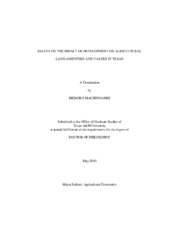| dc.description.abstract | Market land prices ignore the non-market value of ecosystem goods and services; hence, too much agricultural land may be developed. Correct land valuation must include these non-market values. Values of ecosystem services provided by the Richland-Chambers constructed wetlands are assessed through meta-analysis to derive confidence intervals for the willingness-to-pay (WTP) for wetland services. Replacement costs are also used to estimate cost savings of creating wetlands to cleanse river water instead of constructing a conventional wastewater treatment facility. Benefit transfer is used to estimate WTP for non-market agricultural land amenities. Ecosystem services of runoff in the western and recharge in the eastern part of Comal County based on hydrological models are also calculated. Finally, seemingly unrelated regression is used to quantify the effects of growth on current agricultural land values in Texas.
Using two different meta-analysis transfer functions, mean WTP for the Richland-Chambers wetlands are $843 and $999 / acre / year. Estimated 95% confidence interval is $95 to $7,435 / acre / year. This confidence interval clearly indicates the uncertainty associated with valuing ecosystem goods and services. The replacement cost of the Richland?Chambers constructed wetlands is estimated to be $1,688 / acre / year. Aggregate WTP to preserve farm and ranchland non-market amenities in Comal County is estimated to be $1,566 / acre. Using hydrologic models, the runoff is valued at $79 / acre, whereas, recharge value is $1,107 / acre. Development will cause a change in recharge, runoff, and pollution which will decrease societal welfare by $1,288 / acre. Seemingly unrelated regression results show that a percentage increase in population growth in the closest metropolitan statistical area (MSA) is associated with increases in land values of approximately $2 / acre. A one-mile increase in distance from the nearest MSA decreased land values by $4 / acre in 1997, $6 / acre in 2002, and $8 / acre in 2007. The diversity of studies illustrates that a cookbook type of methodology is not appropriate for valuing ecosystem goods and services. On the other hand, development contributes positively to land values through encroachment on agricultural lands. | en |


